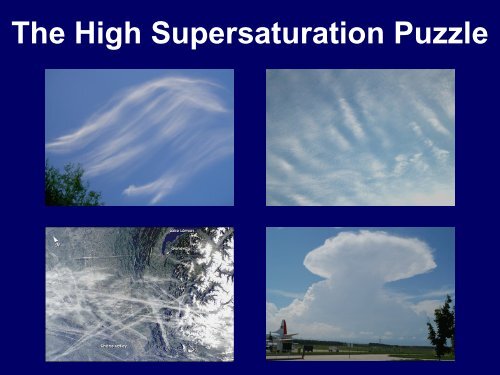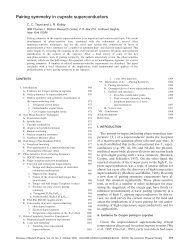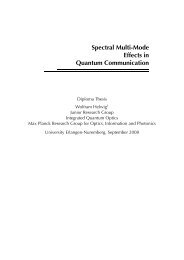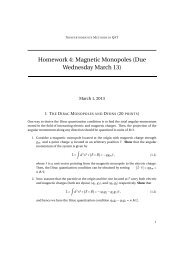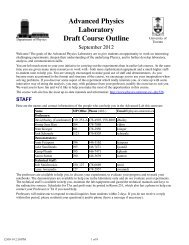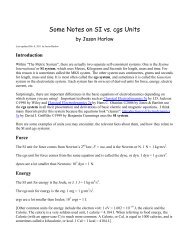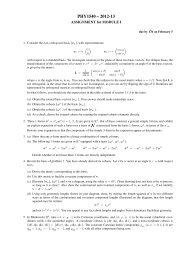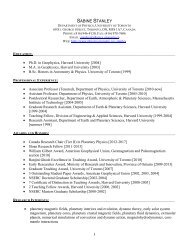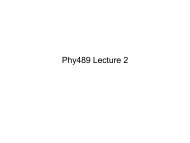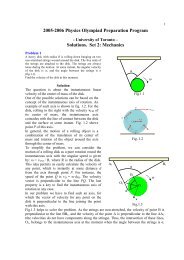PDF file - Department of Physics
PDF file - Department of Physics
PDF file - Department of Physics
Create successful ePaper yourself
Turn your PDF publications into a flip-book with our unique Google optimized e-Paper software.
The High Supersaturation Puzzle
The High Supersaturation Puzzle<br />
Thomas Peter, Claudia Marcolli, Peter Spichtinger,<br />
Thierry Corti<br />
Institute for Atmospheric and Climate Science, ETH Zurich, Switzerland<br />
Marcia Baker<br />
Atmospheric Sciences, University <strong>of</strong> Washington, Seattle, Wash., USA<br />
Thomas Koop<br />
<strong>Department</strong> <strong>of</strong> Chemistry, Bielefeld University, Bielefeld, Germany<br />
Thanks to Martina Krämer, Jülich, and Holger Vömel, NOAA<br />
The discovery <strong>of</strong> massive supersaturations with<br />
respect to ice in upper tropospheric cloud-free air<br />
and inside ice clouds calls into question our<br />
understanding <strong>of</strong> the physics <strong>of</strong> cloud formation.
Saturation ratio with respect to ice:<br />
partial pressure <strong>of</strong> water<br />
vapor pressure <strong>of</strong> ice<br />
S > 1<br />
S = 1<br />
S < 1<br />
ice particles grow<br />
ice particles are in equilibrium with the gas phase<br />
ice particles evaporate<br />
s = S – 1 supersaturation<br />
Relative humidity wrt ice: RHI = S<br />
S = 1 RHI = 100 %
Saturation ratio with respect to ice:<br />
partial pressure <strong>of</strong> water<br />
vapor pressure <strong>of</strong> ice<br />
Arrhenius-type expression for vapor pressure:<br />
p vap (T ) = A e –B/T
Two questions central to our understanding <strong>of</strong> ice<br />
cloud formation:<br />
Nucleation and uptake kinetics:<br />
(1) At what S do we expect ice to nucleate?<br />
(2) Thereafter, how rapidly do we expect ice<br />
to grow and S to equilibrate (S 1)?
ice saturation<br />
ratio S<br />
altitude [km]<br />
14<br />
13<br />
12<br />
14<br />
13<br />
12<br />
14<br />
13<br />
12<br />
2.2<br />
1.6<br />
1<br />
nucleation<br />
threshold<br />
0 time minutes to hours
How do we expect S in a cirrus to develop dynamically?
ice saturation ratio S<br />
The supersaturation puzzle – the observations<br />
2.25<br />
2.00<br />
1.75<br />
(a) Theory (b) Aerosol Chamber (c) Clear Sky (d) In-Cloud/Contrail<br />
Experiment Observations Observations<br />
spontaneous ice nucleation<br />
and vigorous growth<br />
1.50<br />
1.25<br />
clear sky or rapid growth <strong>of</strong><br />
preexisting ice<br />
organic<br />
carbon<br />
on soot<br />
contrails<br />
cirrus<br />
1.00<br />
expected cloud occurrence<br />
0.75 clear sky or ice evaporation<br />
(NH 4 ) 2 SO 4<br />
190 210 230<br />
temperature [K]<br />
190 210 230<br />
temperature [K]<br />
190 210 230<br />
temperature [K]<br />
190 210 230<br />
temperature [K]<br />
Koop et al.,<br />
Nature, 2000<br />
Möhler et al.,<br />
Meteorol. Zs.,<br />
2005,<br />
Abbatt et al.,<br />
Science, 2006<br />
Jensen et al.,<br />
Atmos. Chem.<br />
Phys., 2005<br />
Gao et al.,<br />
Science, 2004
Jensen et al., Atmos. Chem. Phys., 2005<br />
Pre-AVE campaign:<br />
Measurements made<br />
during the descent <strong>of</strong><br />
WB-57:<br />
log-normal aerosol size<br />
distribution with<br />
n = 100 cm −3 ,<br />
r m = 0.025 μ m ,<br />
= 1.4.
5-K averages, all flights<br />
Gao et al., Science, 2004
Lee et al., JGR, 2004:<br />
Measured temperature (blue), RHI (green), IWC (orange), and N4–9<br />
(black) on 23 July 2002 during CRYSTAL-FACE. Temperature and RHI are<br />
1-s averages, IWC is a 10-s average, and N4–9 is a 30-s average.
A meteorological curiosity?<br />
Why should we be interested?
Increasing stratospheric humidity<br />
Important effects:<br />
Stratosphere cools<br />
Stratospheric HO x<br />
chemistry enhanced<br />
H 2<br />
O-trend, frost-point hygrometers above<br />
Colorado 1979-99 (courtesy Sam Oltmans)
Supersatuation:<br />
Decreasing tropical cloudiness?
“T hey live for a short tim e in very high clouds. In a pocket <strong>of</strong> m otionlessness<br />
their temperature will drop to – 40ºC . T hey ought to freeze, but they don’t.”<br />
Peter Høeg, M iss S m illa’s feeling for snow
Water-activity-based ice nucleation theory<br />
H 2<br />
SO 4<br />
HNO 3<br />
HNO 3<br />
/H 2<br />
SO 4<br />
NH 4<br />
HSO 4<br />
(NH 4<br />
) 2<br />
SO 4<br />
NH 4<br />
F<br />
LiCl NaCl KCl<br />
NH 4<br />
Cl CaCl 2<br />
MnCl 2<br />
Ca(NO 3<br />
) 2<br />
H 2<br />
O 2<br />
urea<br />
ethylene glycol glucose
Atmospheric Application<br />
Water Activity<br />
Concentration <strong>of</strong> Aerosol Solution
Dependence <strong>of</strong> nucleation rate on S<br />
An increase<br />
S = 0.05<br />
results in<br />
nuc 10 -6 nuc
ice saturation ratio S<br />
What does this mean for the observations?<br />
2.25<br />
2.00<br />
1.75<br />
(a) Theory (b) Aerosol Chamber (c) Clear Sky (d) In-Cloud/Contrail<br />
Experiment Observations Observations<br />
spontaneous ice nucleation<br />
and vigorous growth<br />
1.50<br />
1.25<br />
clear sky or rapid growth <strong>of</strong><br />
preexisting ice<br />
organic<br />
carbon<br />
on soot<br />
contrails<br />
cirrus<br />
1.00<br />
expected cloud occurrence<br />
0.75 clear sky or ice evaporation<br />
(NH 4 ) 2 SO 4<br />
190 210 230<br />
temperature [K]<br />
190 210 230<br />
temperature [K]<br />
190 210 230<br />
temperature [K]<br />
190 210 230<br />
temperature [K]<br />
nuc 1 min<br />
nuc
How does water vapor condense on ice particles?<br />
5 s<br />
D * <br />
modified diffusion<br />
constant including<br />
limitation by mass<br />
accomodation ()<br />
10<br />
20<br />
CRYSTAL-FACE<br />
600 300 120 s<br />
60 .
How does water vapor condense on ice particles?<br />
Sedimentation<br />
How could supersaturation be maintained?
…<br />
…<br />
Sedimentation<br />
How does water vapor condense on iceparticles?
Steady-state S to a good approximation
Steady-state S in cirrus: traditional microphysical understanding<br />
S = 1.3<br />
w = 0.1 m/s<br />
Low number-density cirrus:<br />
Equilibrium curves for<br />
steady-state S = 1.3.<br />
S = 1.3<br />
w = 1.0 m/s<br />
p = 100 hPa<br />
T = 200 K<br />
= 1<br />
S 0 = 1.6
Steady-state S in cirrus: traditional microphysical understanding<br />
S = 1.3<br />
w = 0.1 m/s<br />
Low number-density cirrus:<br />
Equilibrium curves for<br />
steady-state S = 1.3.<br />
S = 1.3<br />
w = 1.0 m/s<br />
p = 100 hPa<br />
T = 200 K<br />
= 1<br />
S 0 = 1.6<br />
Including<br />
sedimentation<br />
in a layer <strong>of</strong><br />
thickness:<br />
z = 100 m<br />
z = 1000 m
Steady-state S in cirrus: traditional microphysical understanding<br />
w = 1.0 m/s<br />
= 0.1 … 1<br />
CRYSTAL-FACE<br />
S = 1.3<br />
CRYSTAL-<br />
FACE data<br />
could be<br />
explained<br />
assuming<br />
strong<br />
updrafts and<br />
low mass<br />
accommodation<br />
w = 0.1 m/s<br />
= 0.1 … 1<br />
w = 10 m/s<br />
= 0.1 … 1
Steady-state S in cirrus: traditional microphysical understanding<br />
w = 1.0 m/s<br />
= 0.1 … 1<br />
CRYSTAL-FACE<br />
S = 1.1<br />
CRYSTAL-<br />
FACE data<br />
could be<br />
explained<br />
assuming<br />
strong<br />
updrafts and<br />
low mass<br />
accommodation<br />
w = 0.1 m/s<br />
= 0.1 … 1<br />
w = 10 m/s<br />
= 0.1 … 1
Explanations??? Hypotheses??? Speculations???<br />
How good are the data?<br />
Potential out-<strong>of</strong>-cloud effects:<br />
Lack <strong>of</strong> preexisting aerosol?<br />
Underestimated vapor pressure <strong>of</strong> supercooled water?<br />
Surface nucleation?<br />
Potential in-cloud effects:<br />
Control by ice nuclei?<br />
Mesoscale temperature fluctuations?<br />
Subresolution patchiness?<br />
HNO 3 deposition on ice, forming NAT?<br />
Intrinsic limitations on growth <strong>of</strong> ice?<br />
Cubic ice?<br />
Overpopulated tail <strong>of</strong> high velocity molecules?
Several slides with unpublished data<br />
removed here<br />
New results from Pre-AVE campaign<br />
Aircraft-balloon intercomparisons<br />
European measurements from<br />
Geophysica and the German Learjet
Conclusion: how good are the data?<br />
The balloon-borne RHI are significantly<br />
lower than the aircraft-borne RHI = S.<br />
The aircraft-borne data show significant<br />
discrepancies with respect to each other.<br />
However, all data sets show large S – 1,<br />
exceeding the homogeneous freezing limit<br />
and – at times – even exceeding pure<br />
liquid water saturation.<br />
All data show significant persistent<br />
S – 1 >> 0 inside clouds.
Shilling et al., Vapor Pressure <strong>of</strong> Cubic Ice, GRL 2006<br />
RHI<br />
cub<br />
hex<br />
Gao et al.; Harvard water vapor instrument<br />
Shilling et al.: JPL tunable diode laser hygrometer<br />
> sublimation <strong>of</strong> crystals in the inlet <strong>of</strong> the HWV can result in anomalously<br />
high H 2 O<br />
> include only measurements when cond < 3 minutes<br />
> include only measurements when w < 0.5 m/s
Explanations??? Hypotheses??? Speculations???<br />
How good are the data?<br />
Potential out-<strong>of</strong>-cloud effects:<br />
Lack <strong>of</strong> preexisting aerosol?<br />
Underestimated vapor pressure <strong>of</strong> supercooled water?<br />
Surface nucleation?<br />
Potential in-cloud effects:<br />
Control by ice nuclei?<br />
Mesoscale temperature fluctuations?<br />
Subresolution patchiness?<br />
HNO3 deposition on ice, forming NAT?<br />
Intrinsic limitations on growth <strong>of</strong> ice?<br />
Cubic ice?<br />
Overpopulated tail <strong>of</strong> high velocity molecules?
Potential out-<strong>of</strong>-cloud effects:<br />
Lack <strong>of</strong> preexisting aerosol?<br />
Jensen et al., 2005:<br />
Measurements made during the<br />
descent:<br />
log-normal aerosol size distribution<br />
n = 100 cm −3 , r m = 0.025 μ m , = 1.4<br />
Debra Weisenstein, 2-D<br />
aerosol model, from<br />
“A ssessm ent <strong>of</strong> S tratospheric<br />
A erosol P roperties”,<br />
SPARC Report
Potential out-<strong>of</strong>-cloud effects:<br />
Underestimated vapor pressure <strong>of</strong> supercooled water?<br />
Outside ice clouds the determination <strong>of</strong> the relative<br />
humidity at which ice nucleation occurs depends also on<br />
the saturation vapor pressure <strong>of</strong> supercooled water,<br />
which has to be extrapolated for use below 230 K (8),<br />
possibly leading to errors up to 20 %.<br />
However, if the error was really that large, should it not<br />
have been caught in laboratory experiments?
ice saturation ratio S<br />
Potential out-<strong>of</strong>-cloud effects:<br />
Surface nucleation?<br />
If water-rich aerosols are<br />
covered by organic<br />
surfactants, nucleation might<br />
be suppressed if it starts at the<br />
surface (A. Tabazadeh and<br />
coworkers).<br />
But evidence for surface<br />
nucleation is controversial.<br />
Furthermore, it is not known<br />
how likely complete coverage<br />
by organics on the aerosols is.<br />
2.25<br />
2.00<br />
1.75<br />
1.50<br />
1.25<br />
1.00<br />
(a) Theory<br />
spontaneous ice nucleation<br />
and vigorous growth<br />
clear sky or rapid growth <strong>of</strong><br />
preexisting ice<br />
expected cloud occurrence<br />
0.75 clear sky or ice evaporation<br />
(NH 4 ) 2 SO 4<br />
190 210 230<br />
temperature [K]<br />
(b) Aerosol Chamber<br />
Experiment<br />
organic<br />
carbon<br />
on soot<br />
190 210 230<br />
temperature [K]
Potential in-cloud effects:<br />
Control by ice nuclei?<br />
The presence <strong>of</strong> heterogeneous ice nuclei in<br />
cloud-free air may initiate ice nucleation below the<br />
homogeneous nucleation threshold, leading to<br />
clouds with low ice particle number densities, in<br />
which supersaturations might be sustained for<br />
relatively long periods.<br />
… but how can this provide a persistent effect?
Potential in-cloud effects:<br />
Mesoscale temperature fluctuations?<br />
T oscillations – due to<br />
the nonlinearity <strong>of</strong> the<br />
Clausius-Clapeyron<br />
equation – may cause<br />
average<br />
supersaturations.<br />
… but average is not<br />
persistent, and the effect<br />
is moderate.<br />
Campaigns:<br />
A SUCCESS<br />
B CRYSTAL-FACE<br />
C SESAME PSC<br />
t / 2 cond
Potential in-cloud effects:<br />
Subresolution patchyness?<br />
Cirrocumulus undulatus, 15 Sept 2006 above Zürich
Potential in-cloud effects:<br />
HNO 3 deposition on ice, forming NAT?<br />
From Gao<br />
et al.,<br />
Science<br />
2004<br />
Blocking<br />
<strong>of</strong> growth<br />
sites?<br />
But no lab<br />
evidence!.
Potential in-cloud effects:<br />
Intrinsic limitations on growth <strong>of</strong> ice?<br />
Pratte et al., The Kinetics <strong>of</strong> H 2 O<br />
Vapor Condensation and Evaporation<br />
on Different Types <strong>of</strong> Ice in the<br />
Range 130-210 K, JPC, 2006
ice saturation ratio S<br />
Potential in-cloud effects:<br />
Cubic ice?<br />
Recent laboratory<br />
studies have shown that<br />
below 200 K a<br />
metastable form <strong>of</strong> ice –<br />
cubic ice – nucleates<br />
first and might persist in<br />
clouds. The equilibrium<br />
vapor pressure for cubic<br />
ice is about 10 % higher<br />
than that over stable<br />
hexagonal ice.<br />
2.25<br />
2.00<br />
1.75<br />
1.50<br />
1.25<br />
1.00<br />
0.75<br />
(a) Theory<br />
spontaneous ice nucleation<br />
and vigorous growth<br />
clear sky or rapid growth <strong>of</strong><br />
preexisting ice<br />
expected cloud occurrence<br />
clear sky or ice evaporation<br />
190 210 230<br />
temperature [K]<br />
contrails<br />
(d) In-Cloud/Contrail<br />
Observations<br />
cirrus<br />
190 210 230<br />
temperature [K]<br />
But unlikely higher!
Potential in-cloud effects:<br />
Overpopulated tail <strong>of</strong> high velocity molecules?<br />
Molecular velocity distributions and generalized scale<br />
invariance in the turbulent atmosphere<br />
Tuck et al., Faraday Discuss., 2005<br />
An overpopulated tail <strong>of</strong> high velocity molecules in atmospheric<br />
probability distribution functions will also affect the access <strong>of</strong> condensable<br />
vapours to particle surfaces, particularly in the case <strong>of</strong> water, which as a<br />
relatively light molecule may be expected to show a relatively high<br />
overpopulation <strong>of</strong> translationally hot molecules. Calculations <strong>of</strong> vapour<br />
flux to ice crystals, for example in polar stratospheric clouds or high cirrus<br />
near the tropical tropopause, could incur substantial error by using<br />
traditional x 2 2 Dt formulations <strong>of</strong> molecular diffusion.<br />
… how ever, isn’t this contradicting laboratory evidence?
Summary <strong>of</strong> Potential Explanations:<br />
Data quality:<br />
There are significant discrepancies whose origin needs to be investigated!<br />
However, there is little doubt that the observed S cannot be explained on<br />
the basis <strong>of</strong> traditional microphysics!<br />
Potential out-<strong>of</strong>-cloud effects:<br />
Lack <strong>of</strong> preexisting aerosol?<br />
But air masses would need to be almost void <strong>of</strong> aqueous aerosols.<br />
Underestimated vapor pressure <strong>of</strong> supercooled water?<br />
But the required > 20 % error is not supported by laboratory evidence.<br />
Surface nucleation?<br />
If ice nucleated at aerosol surface and the surface was completely<br />
covered by organics …
Summary <strong>of</strong> Potential Explanations:<br />
Potential in-cloud effects:<br />
Control by ice nuclei?<br />
Ice nuclei might suppress homogeneous nucleation, but it remains<br />
unclear how this can lead to persistent S > 1.<br />
Mesoscale temperature fluctuations?<br />
Due to the nonlinearity <strong>of</strong> the Clausius-Clapeyron relation, fluctuations<br />
cause an average, but not the observed continuous supersaturation.<br />
Subresolution patchiness?<br />
Ice patchiness may cause apparent in-cloud supersaturation, but a<br />
verification will have to await higher resolution instrumentation.<br />
HNO 3 deposition on ice, forming NAT?<br />
Nitric acid trihydrate (NAT) blocking growth sites on the ice, but<br />
laboratory investigations <strong>of</strong> this effect are not clarifying the issue.<br />
Intrinsic limitations on growth <strong>of</strong> ice?<br />
Recent lab studies suggest impeded growth due to low H 2 O mass<br />
accommodation, but how can the resulting S be as persistent?<br />
Cubic ice?<br />
Lab studies show that cubic ice forms as a transient at temperatures<br />
below 190 K, but this cannot explain S > 1.1.<br />
Overpopulated tail <strong>of</strong> high velocity molecules?<br />
Translationally hot water molecules could reduce the access <strong>of</strong> condensable<br />
vapor to particle surfaces, but w/o experimental evidence.
Summary <strong>of</strong> Potential Explanations:<br />
The way forward?<br />
Suggestion:<br />
Dedicated workshop: involved instrumentalists,<br />
key lab people, key cloud/aerosol modellers and ice<br />
theoreticians!<br />
Dedicated instrument intercomparisons, e.g. in a<br />
cloud chamber!<br />
Dedicated lab investigations on impurities on ice!


